关于美国教育英语作文
中国教育和美国教育的不同英语作文
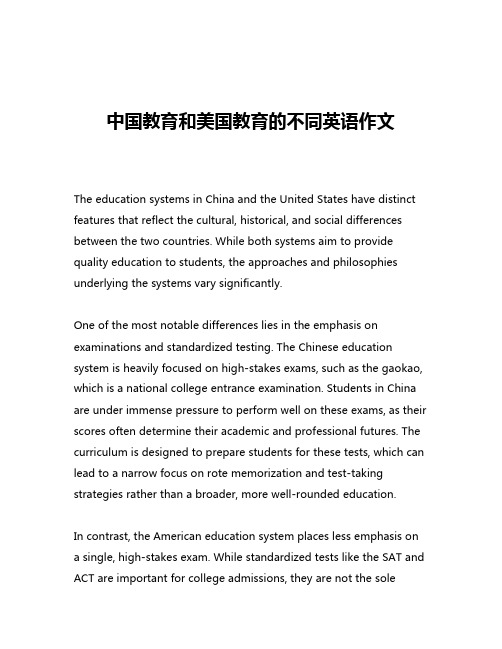
中国教育和美国教育的不同英语作文The education systems in China and the United States have distinct features that reflect the cultural, historical, and social differences between the two countries. While both systems aim to provide quality education to students, the approaches and philosophies underlying the systems vary significantly.One of the most notable differences lies in the emphasis on examinations and standardized testing. The Chinese education system is heavily focused on high-stakes exams, such as the gaokao, which is a national college entrance examination. Students in China are under immense pressure to perform well on these exams, as their scores often determine their academic and professional futures. The curriculum is designed to prepare students for these tests, which can lead to a narrow focus on rote memorization and test-taking strategies rather than a broader, more well-rounded education.In contrast, the American education system places less emphasis on a single, high-stakes exam. While standardized tests like the SAT and ACT are important for college admissions, they are not the soledeterminant of a student's academic success. The curriculum in the United States is generally more diverse, with a greater emphasis on critical thinking, problem-solving, and the development of a wide range of skills and knowledge.Another key difference lies in the role of the teacher. In the Chinese education system, teachers are often seen as authoritative figures who impart knowledge to students. The teacher-student relationship is more formal, and students are expected to respect and obey their teachers. Classroom instruction is typically teacher-centered, with the teacher delivering lectures and students taking notes.On the other hand, the American education system places a greater emphasis on student-centered learning. Teachers are more facilitators of learning, guiding students to discover and construct knowledge for themselves. Classroom activities often involve group discussions, project-based learning, and hands-on activities that encourage students to engage actively with the material.The level of parental involvement in education also differs between the two countries. In China, parents play a crucial role in their children's education, often closely monitoring their academic progress and providing extensive support and guidance. Parental pressure to excel academically is a significant factor in the Chinese education system.In the United States, while parental involvement is encouraged, the level of involvement tends to be more varied. Some parents are heavily involved in their children's education, while others take a more hands-off approach. The American education system also places a greater emphasis on the development of well-rounded individuals, with extracurricular activities and community involvement playing a more significant role.One area where the Chinese and American education systems share some similarities is the increasing focus on STEM (Science, Technology, Engineering, and Mathematics) education. Both countries recognize the importance of developing a strong foundation in these fields to prepare students for the demands of the 21st-century workforce. However, the approaches to STEM education may differ, with the Chinese system placing a greater emphasis on rote learning and mastery of technical skills, while the American system encourages more interdisciplinary and problem-based learning.Despite these differences, both the Chinese and American education systems have their strengths and weaknesses. The Chinese system's emphasis on academic rigor and discipline has produced many high-achieving students, but it has also been criticized for its narrow focus and the immense pressure it places on students. The Americansystem's emphasis on well-rounded education and student-centered learning has produced creative and critical thinkers, but it has also been criticized for a perceived lack of academic rigor.As the world becomes increasingly globalized, there is a growing recognition of the need for a more balanced and integrated approach to education. Both China and the United States can learn from each other's successes and shortcomings, and work towards developing education systems that nurture the holistic development of students while also preparing them for the challenges of the modern world.。
中国和美国教育方式的差异英语作文

中国和美国教育方式的差异英语作文Education plays a crucial role in shaping the future of individuals and societies. The methods and approaches to education vary significantly across different cultures and countries. Two of the most contrasting systems can be found in China and the United States. Both nations emphasize the importance of education, but their methods reflect their unique cultural, social, and historical backgrounds. This essay explores the key differences in educational methods between China and the United States, highlighting the strengths and challenges of each system.One of the fundamental differences between Chinese and American education lies in their educational philosophies. In China, the education system is highly influenced by Confucianism, which emphasizes respect for authority, the value of hard work, and the importance of education in achievingsocietal harmony and individual success. As a result, Chinese education tends to be more rigid, hierarchical, and exam-oriented. The primary objective is to impart knowledge and skills that will enable students to excel academically and contribute to society.In contrast, the American education system is shaped by the principles of individualism, critical thinking, and creativity. The focus is on developing well-rounded individuals who can think independently, solve problems, and innovate. Education in the United States aims to foster personal growth, self-expression, and the ability to adapt to a rapidly changing world. This difference in philosophy leads to varying approaches to teaching and learning in the two countries.The curriculum in China is highly standardized and centralized. The Ministry of Education dictates the content and structure of the curriculum, which ensures uniformity across the country. Students in China follow a rigorous and demandingschedule, with a strong emphasis on core subjects such as mathematics, science, and Chinese language. Memorization and rote learning are common practices, as students are often required to recall vast amounts of information for exams. The high-stakes nature of these exams, particularly the Gaokao (college entrance examination), puts immense pressure on students to perform well.In contrast, the American curriculum is more flexible and decentralized. While there are national standards and guidelines, local school districts have significant autonomy in designing their curricula. This allows for a more diverse range of subjects and extracurricular activities, catering to the varied interests and talents of students. American education places a strong emphasis on critical thinking, problem-solving, and hands-on learning. Project-based learning, group discussions, and interactive activities are common in American classrooms, fostering an environment where students can explore their interests and develop practical skills.Chinese classrooms are typically characterized by a teacher-centered approach. Teachers are viewed as authoritative figures who impart knowledge to students, who are expected to listen, take notes, and memorize the information. The classroom environment is generally formal and disciplined, with a focus on maintaining order and respect for the teacher. This approach can lead to a deep understanding of core subjects but may limit opportunities for creative expression and critical thinking.In the United States, the classroom environment is often more relaxed and student-centered. Teachers act as facilitators who guide and support students in their learning journey. There is a strong emphasis on interactive and participatory learning, where students are encouraged to ask questions, express their opinions, and engage in discussions. Group work and collaborative projects are common, promoting teamwork and communication skills. This approach nurtures creativity andindependent thinking but may sometimes lead to less emphasis on mastering core academic content.Assessment methods in China are heavily focused on exams and standardized testing. Students’ performance is primarily evaluated based on their ability to recall and apply knowledge in written tests. The Gaokao is the most critical exam in a Chinese student’s academic career, as it determines their eligibility for higher education and future career prospects. The intense focus on exams can lead to a highly competitive environment, where students are motivated to achieve high scores but may experience significant stress and pressure.In the United States, assessment is more varied and holistic. While standardized tests are still important, they are complemented by other forms of evaluation, such as assignments, projects, presentations, and class participation. This approach aims to provide a more comprehensive picture of a student’s abilities and achievements. Continuous assessmentand formative feedback help students identify their strengths and areas for improvement, fostering a growth mindset and encouraging lifelong learning.Parental involvement is another area where Chinese and American education systems differ significantly. In China, parents p lay a crucial role in their children’s education, often taking a hands-on approach to ensure academic success. They may hire tutors, supervise homework, and set high expectations for their children’s performance. This strong support system can drive students to excel but may also contribute to increased pressure and anxiety.In the United States, parental involvement varies widely but generally emphasizes supporting children’s overall development and well-being. Parents are encouraged to participate in school activities, communicate with teachers, and support their children’s interests and aspirations. The focus is on creating a balanced environment where academicachievement is valued but not at the expense of personal growth and happiness.In conclusion, the educational methods in China and the United States reflect their distinct cultural values and societal goals. While the Chinese system emphasizes discipline, hard work, and academic excellence, the American system prioritizes creativity, critical thinking, and holistic development. Both approaches have their strengths and challenges, and there is much that each country can learn from the other. By understanding and appreciating these differences, educators and policymakers can work towards creating more effective and inclusive education systems that prepare students for the demands of the globalized world.。
美国教育英文作文
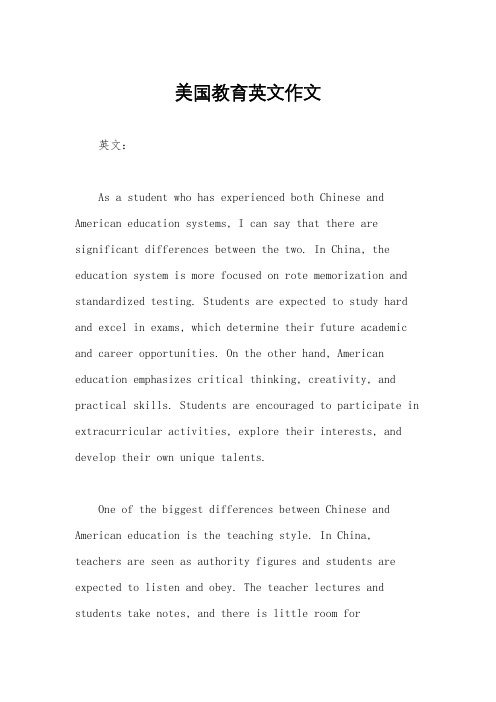
美国教育英文作文英文:As a student who has experienced both Chinese and American education systems, I can say that there are significant differences between the two. In China, the education system is more focused on rote memorization and standardized testing. Students are expected to study hard and excel in exams, which determine their future academic and career opportunities. On the other hand, American education emphasizes critical thinking, creativity, and practical skills. Students are encouraged to participate in extracurricular activities, explore their interests, and develop their own unique talents.One of the biggest differences between Chinese and American education is the teaching style. In China, teachers are seen as authority figures and students are expected to listen and obey. The teacher lectures and students take notes, and there is little room fordiscussion or debate. In contrast, American teachers act more like facilitators, encouraging students to ask questions, share their opinions, and engage in debates. Students are encouraged to think critically and express themselves freely.Another difference is the grading system. In China, grades are everything. Students are judged solely on their exam scores and academic achievements. In America, grades are important, but they are not everything. Students arealso evaluated on their participation, behavior, andoverall effort. This encourages students to be well-rounded and develop their social skills as well as their academic abilities.Finally, the role of parents in education is differentin China and America. In China, parents are heavilyinvolved in their children's education, often hiring tutors and pushing them to excel academically. In America, parents are encouraged to be involved in their children's education, but not to the point of micromanaging. American parents are more focused on supporting their children's interests andpassions, rather than just their academic success.中文:作为一名经历过中国和美国教育系统的学生,我可以说两者之间存在着显著的差异。
你对美国教育和英国教育的看法英语作文

你对美国教育和英国教育的看法英语作文Education plays a crucial role in shaping a country's future and the potential of its citizens. In this essay, I will discuss my views on the education systems in the United States and the United Kingdom.The United States and the United Kingdom are two countries with diverse education systems that have their own strengths and weaknesses. In the United States, education is primarily managed at the state level, leading to a wide variation in standards and curricula across different states. This can be both a blessing and a curse, as it allows for flexibility and innovation, but can also lead to disparities in education quality.One of the key strengths of the American education system is its emphasis on extracurricular activities and a well-rounded education. Students in the US have access to a wide range of sports, arts, and other activities that help develop their social, emotional, and physical skills. This holistic approach to education helps students become well-rounded individuals who are prepared for the challenges of the real world.However, the American education system has been criticized for its lack of standardized testing and accountability. Theemphasis on standardized testing can lead to a "teach to the test" mentality, where teachers focus on preparing students for exams rather than fostering critical thinking and creativity. Additionally, the funding of public schools in the US is often based on property taxes, leading to disparities in resources and opportunities between wealthy and low-income communities.On the other hand, the education system in the United Kingdom is more centralized and structured. The national curriculum sets out what children should be learning at each stage of their education, providing a clear framework for teachers and students to follow. This can help ensure a consistent level of education quality across all regions of the country.One of the strengths of the British education system is its focus on academic rigor and specialization. Students in the UK are encouraged to specialize in certain subjects from an early age, allowing them to develop expertise and deep knowledge in their chosen fields. This can help prepare students for higher education and future careers in specialized fields.However, the British education system has been criticized for its lack of emphasis on extracurricular activities and holistic education. Students in the UK may not have as manyopportunities to participate in sports, arts, or other activities outside of the academic curriculum. This can lead to a focus on academic achievement at the expense of social and emotional development.In conclusion, both the American and British education systems have their own strengths and weaknesses. The American system encourages innovation and creativity, while the British system provides a structured and rigorous academic framework. By learning from each other's strengths and addressing weaknesses, both countries can work towards providing ahigh-quality education for all students. Education is a key investment in the future of our societies, and it is essential that we continue to strive for excellence in our education systems.。
美式教育缺点英语作文
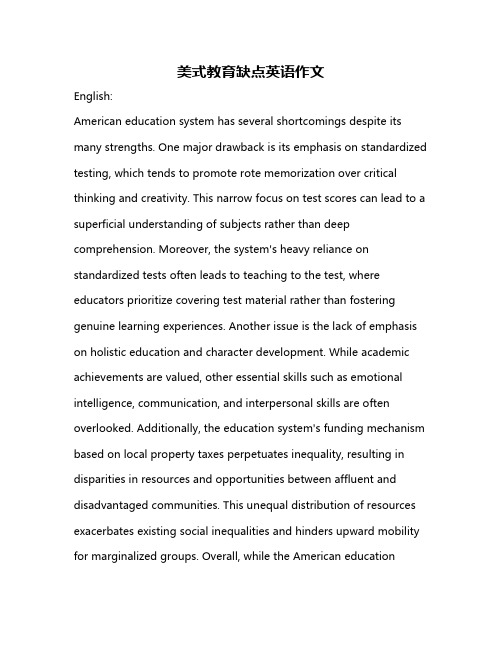
美式教育缺点英语作文English:American education system has several shortcomings despite its many strengths. One major drawback is its emphasis on standardized testing, which tends to promote rote memorization over critical thinking and creativity. This narrow focus on test scores can lead to a superficial understanding of subjects rather than deep comprehension. Moreover, the system's heavy reliance on standardized tests often leads to teaching to the test, where educators prioritize covering test material rather than fostering genuine learning experiences. Another issue is the lack of emphasis on holistic education and character development. While academic achievements are valued, other essential skills such as emotional intelligence, communication, and interpersonal skills are often overlooked. Additionally, the education system's funding mechanism based on local property taxes perpetuates inequality, resulting in disparities in resources and opportunities between affluent and disadvantaged communities. This unequal distribution of resources exacerbates existing social inequalities and hinders upward mobility for marginalized groups. Overall, while the American educationsystem excels in certain areas, its overemphasis on standardized testing, neglect of holistic education, and perpetuation of socioeconomic disparities are significant shortcomings that need addressing.Translated content:美国教育系统尽管有许多优点,但也存在一些缺点。
美国教育的三级管理制度的英文作文

美国教育的三级管理制度英语作文1The United States has a distinctive three-level management system in education, which plays a crucial role in shaping the quality and accessibility of educational opportunities for its citizens.At the federal level, the government is responsible for setting broad educational quality standards. It formulates policies that aim to ensure that all students receive a basic level of education that prepares them for future challenges. For instance, it might define certain benchmarks for literacy and numeracy skills that students should achieve.The state governments hold significant power in areas such as curriculum design. They determine the subjects and content that students will study, tailoring it to the specific needs and values of the state. Additionally, they play a leading role in teacher certification, ensuring that educators meet specific standards of knowledge and competence.Local school districts are at the forefront of school resource allocation. They decide how funds are distributed among schools to purchase necessary equipment and materials. They also handle the day-to-day management of teaching, including scheduling classes and organizing extracurricular activities.This three-level system works in tandem to provide a diverse andcomprehensive educational experience. Each level has its unique responsibilities and contributions, collectively striving to offer quality education that meets the diverse needs of students across the nation. The collaboration and balance among the federal, state, and local levels are essential for the continuous improvement and success of the American educational system.2The three-level management system of education in the United States plays a crucial role in shaping the educational landscape of the country. At the federal level, the government provides substantial financial support, which has significantly contributed to promoting educational equity. For instance, it funds educational programs for disadvantaged students, ensuring they have access to quality education. However, there might be inconsistencies in the implementation of policies across different states.The state governments, on the other hand, enjoy flexibility in formulating policies to meet the specific needs of their localities. This adaptability allows for customization based on regional characteristics and priorities. However, it could potentially lead to significant differences in educational standards and opportunities among different states.The local school districts have direct management over educational institutions within their boundaries. They are better positioned to understand and address the needs of the local community. But the resourceallocation could be imbalanced, with some districts having abundant resources while others struggle to meet basic requirements.In conclusion, the three-level management system of education in the United States has its strengths and challenges. A balanced and coordinated approach among the federal, state, and local authorities is essential to optimize the educational system and provide quality education for all students.3The educational management system in the United States is characterized by a three-level administrative structure, which sets it apart from many other countries. In contrast to the centralized educational management model in some European countries, the United States grants more autonomy to states and local communities. For instance, in certain European nations, educational policies and curricula are often dictated by the central government, leaving little room for local variations and adaptations. However, in the United States, states have the authority to formulate their own educational standards and curricula, based on the specific needs and circumstances of their regions.When compared to some Asian countries where local autonomy is relatively limited, the American system provides greater flexibility and innovation at the local level. In these Asian countries, educational decisions are often made at the national level, and local authorities have less say inshaping educational programs. In the United States, local school districts can make decisions regarding teaching methods, resource allocation, and even the selection of textbooks, which allows for a more tailored educational experience for students.This decentralized approach in the United States has both advantages and challenges. On the one hand, it encourages diversity and experimentation, enabling different regions to develop educational models that suit their unique demographics and cultural contexts. It also promotes community engagement and accountability, as local stakeholders have a direct influence on the quality of education. On the other hand, it can lead to disparities in educational quality between different states and districts, as resources and capabilities vary.Overall, the three-level management system of education in the United States offers a distinct framework that emphasizes local autonomy and flexibility, while also presenting ongoing opportunities for improvement and balance to ensure equal educational opportunities for all students.4The three-level management system of education in the United States plays a crucial role in shaping the educational landscape and influencing the learning outcomes and quality of education for students. This system, which typically consists of federal, state, and local levels, has both positiveand negative impacts.In some areas where the system functions effectively, students have witnessed remarkable improvements in their academic achievements. For instance, in states with well-defined educational policies and adequate resource allocation at the state and local levels, schools are equipped with modern facilities and highly qualified teachers. This leads to students having access to a rich and diverse curriculum, and as a result, they perform exceptionally well in standardized tests and are well-prepared for higher education and future careers.However, in other regions where management is not as efficient, the quality of education varies significantly. Insufficient funding at the local level may result in outdated textbooks and limited extracurricular activities. Moreover, a lack of coherent policies between the federal and state levels can cause confusion among educators and hinder the implementation of effective teaching methods. This can have a detrimental effect on students' learning experiences and overall educational attainment.In conclusion, the three-level management system of education in the United States has the potential to provide high-quality education when properly coordinated and implemented. However, it also poses challenges that need to be addressed to ensure that all students receive a fair and excellent education regardless of their geographical location.5The three-level management system of education in the United States has long been an important framework shaping the educational landscape. However, as technology continues to advance and social needs evolve, significant changes are likely on the horizon.One notable trend could be a greater emphasis on personalized education. With the aid of advanced analytics and artificial intelligence, educational institutions may be able to tailor curricula and learning paths to the unique strengths and weaknesses of each student. This would not only enhance learning outcomes but also foster a more engaged and motivated student body.Another potential development is the seamless integration of online education resources. The digital revolution has opened up a world of educational possibilities, allowing students to access high-quality courses and materials from anywhere. This could lead to a more equitable distribution of educational opportunities, breaking down geographical and economic barriers.Furthermore, there might be a shift towards interdisciplinary learning. In a rapidly changing world, the boundaries between traditional subjects are blurring. Encouraging students to draw connections across various fields of knowledge will better prepare them for the complex challenges of the future.In conclusion, the future of the three-level management system of education in the United States appears promising, with a focus on customization, digitalization, and interdisciplinarity. These changes have the potential to revolutionize education and ensure that students are equipped with the skills and knowledge needed to thrive in the 21st century.。
美国教育和中国教育的不同的英语作文
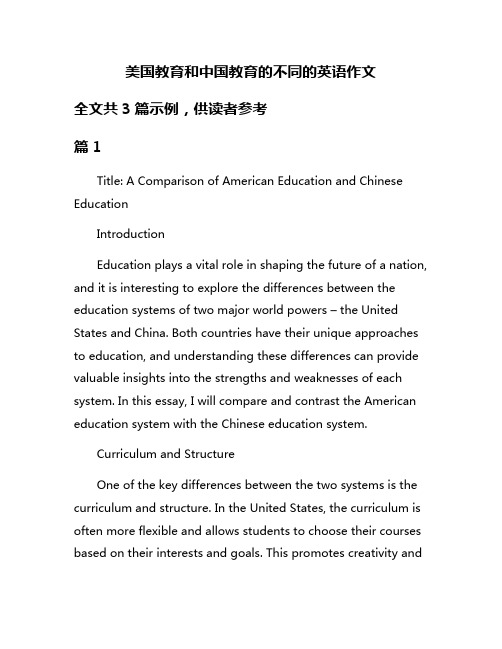
美国教育和中国教育的不同的英语作文全文共3篇示例,供读者参考篇1Title: A Comparison of American Education and Chinese EducationIntroductionEducation plays a vital role in shaping the future of a nation, and it is interesting to explore the differences between the education systems of two major world powers – the United States and China. Both countries have their unique approaches to education, and understanding these differences can provide valuable insights into the strengths and weaknesses of each system. In this essay, I will compare and contrast the American education system with the Chinese education system.Curriculum and StructureOne of the key differences between the two systems is the curriculum and structure. In the United States, the curriculum is often more flexible and allows students to choose their courses based on their interests and goals. This promotes creativity andpersonalized learning, as students have the freedom to explore a wide range of subjects.In contrast, the Chinese education system is more structured and focused on rote learning. Students are required to follow a strict curriculum and memorize large amounts of information for exams. While this approach may lead to high academic achievement, it can limit critical thinking and creativity among students.Standardized TestingStandardized testing is another area where the two systems differ significantly. In the United States, standardized tests such as the SAT and ACT are used as a tool for college admissions. While these tests are important, they are just one of many factors considered in the admissions process.In China, however, standardized testing plays a much larger role in determining a student's academic success. The gaokao, or national college entrance exam, is a high-stakes test that can determine a student's future. Students spend years preparing for this exam, and their scores can have a significant impact on their future opportunities.Teaching MethodsTeaching methods in the two countries also differ. In the United States, the focus is often on student-centered learning, where teachers act as facilitators and guides rather than lecturers. This approach encourages critical thinking and collaboration among students.In China, teaching tends to be more teacher-centered, with an emphasis on authority and respect for teachers. Students are expected to listen and follow instructions, and there is less room for discussion and debate in the classroom.Extracurricular ActivitiesExtracurricular activities are an important part of education in both countries, but they are approached in different ways. In the United States, students are encouraged to participate in a wide range of activities, from sports to music to community service. These activities help students develop leadership skills, teamwork, and social connections.In China, extracurricular activities are often seen as distractions from academic studies. While some schools offer activities such as sports and art clubs, the focus is primarily on academics. This can limit students' opportunities to explore their interests and develop their talents outside of the classroom.ConclusionIn conclusion, the education systems of the United States and China have distinct differences in curriculum, standardized testing, teaching methods, and extracurricular activities. While both systems have their strengths and weaknesses, understanding these differences can provide valuable insights into how each country approaches education and prepares its students for the future. By examining the similarities and differences between the two systems, we can learn from each other and work towards creating a more effective and inclusive education system for all students.篇2Education is an essential part of any country's development, shaping the minds of future generations and preparing them for the challenges of the world. While the ultimate goal of education is universal – to educate and empower individuals – the methods, systems, and priorities can vary greatly between countries. In this essay, we will explore the differences between education in the United States and China.One of the biggest differences between education in the United States and China is the structure of the education system.In the United States, education is decentralized, with each state responsible for its own educational policies and curriculum. This has led to a wide variation in the quality of education between states, with some states consistently ranking higher in educational outcomes than others. On the other hand, China has a centralized education system, with the government setting the curriculum and standards for all schools in the country. This has led to a more standardized education experience for students across China, but has also been criticized for stifling creativity and innovation.Another key difference between education in the United States and China is the focus on standardized testing. In the United States, standardized testing such as the SAT and ACT are used to assess students' academic performance and determine college admissions. While these tests are controversial and have been criticized for promoting rote memorization over critical thinking skills, they are still a key part of the American education system. In China, standardized testing is even more prevalent, with the infamous Gaokao exam determining a student's entire future. The Gaokao is a high-stakes exam that determines which university a student can attend, and has been criticized for putting too much pressure on students and promoting a narrow definition of success.In terms of teaching methods, there are also significant differences between the United States and China. In the United States, there is a greater emphasis on creativity, critical thinking, and student-centered learning. Teachers often use interactive and hands-on teaching methods to engage students and encourage them to think for themselves. In China, on the other hand, the focus is more on rote memorization and traditional teaching methods. Students are expected to memorize large amounts of information and perform well on exams, rather than explore their own interests and passions.Another important difference between education in the United States and China is the role of extracurricular activities. In the United States, extracurricular activities such as sports, arts, and clubs are seen as an important part of a student's education, helping them develop important skills such as teamwork, leadership, and time management. In China, however, extracurricular activities are often seen as a distraction from academic studies, and students are encouraged to focus solely on their schoolwork.In conclusion, while both the United States and China value education as a key part of their national development, there are significant differences in the structure, methods, and priorities oftheir education systems. The United States focuses on creativity, critical thinking, and student-centered learning, while China emphasizes rote memorization, standardized testing, and academic achievement. Both systems have their strengths and weaknesses, and there is much that each country can learn from the other in order to improve the quality of education for all students.篇3Differences Between Education in the United States and ChinaIntroductionEducation plays a crucial role in shaping individuals and societies as a whole. The educational systems in various countries around the world differ in terms of curriculum, teaching methods, assessment methods, and cultural context. In this essay, we will explore the differences between education in the United States and China.CurriculumOne of the primary differences between education in the United States and China is the curriculum. In the United States, the curriculum is more flexible and allows students to choosefrom a wide range of subjects. Students can explore different areas of interest and develop a well-rounded knowledge base. In contrast, the Chinese education system has a more rigid curriculum that focuses heavily on academic subjects such as mathematics, science, and language.Teaching MethodsAnother key difference between education in the United States and China is the teaching methods. In the United States, there is an emphasis on critical thinking, creativity, and independent learning. Teachers often use interactive and collaborative teaching methods to engage students and encourage them to think creatively. On the other hand, the Chinese education system places a greater emphasis on rote learning and memorization. Teachers in China tend to use more traditional teaching methods, such as lectures and drills.Assessment MethodsThe assessment methods used in education also differ between the United States and China. In the United States, students are often assessed through a combination of tests, essays, projects, and presentations. There is an emphasis on continuous assessment and feedback to help students improve their learning. In China, students are primarily assessed throughstandardized tests, such as the gaokao (national college entrance exam). These high-stakes exams can have a significant impact on student's future educational and career prospects.Cultural ContextThe cultural context in which education takes place also plays a significant role in shaping the educational systems in the United States and China. In the United States, there is a strong emphasis on individualism, creativity, and diversity. Students are encouraged to express themselves, think critically, and pursue their own interests. In China, there is a greater emphasis on conformity, discipline, and hard work. Students are expected to follow rules, respect authority, and strive for academic excellence.ConclusionIn conclusion, education in the United States and China differs in terms of curriculum, teaching methods, assessment methods, and cultural context. While the United States emphasizes flexibility, creativity, and critical thinking, China focuses on academic rigor, rote learning, and discipline. Both systems have their strengths and weaknesses, and there is much to be learned from each other. By understanding and appreciating the differences in education systems, we can worktowards creating more effective and inclusive educational opportunities for all students.。
英美教育比较英文小作文
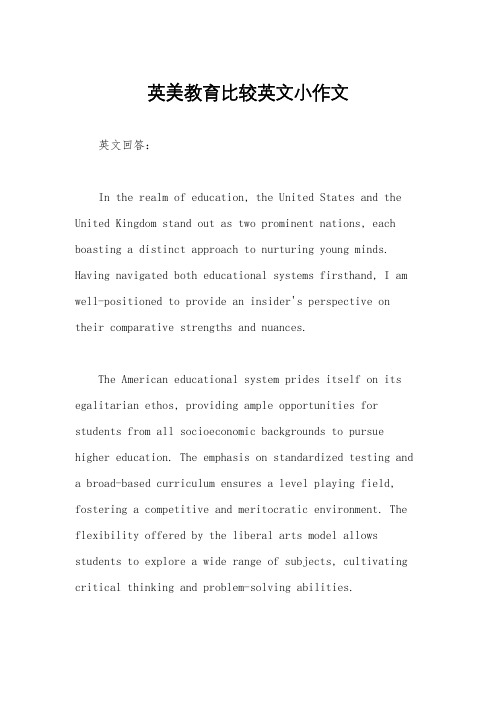
英美教育比较英文小作文英文回答:In the realm of education, the United States and the United Kingdom stand out as two prominent nations, each boasting a distinct approach to nurturing young minds. Having navigated both educational systems firsthand, I am well-positioned to provide an insider's perspective on their comparative strengths and nuances.The American educational system prides itself on its egalitarian ethos, providing ample opportunities for students from all socioeconomic backgrounds to pursue higher education. The emphasis on standardized testing and a broad-based curriculum ensures a level playing field, fostering a competitive and meritocratic environment. The flexibility offered by the liberal arts model allows students to explore a wide range of subjects, cultivating critical thinking and problem-solving abilities.Moreover, the American university landscape is vast and diverse, featuring both public and private institutions, ranging from ivy-league powerhouses to smaller, more specialized colleges. This allows students to tailor their education to their specific interests and career aspirations. The vibrant campus life, with its plethora of clubs, sports, and social activities, provides a rich and well-rounded experience beyond the classroom.In contrast, the British educational system is renowned for its tradition and academic rigor. The emphasis on early specialization, beginning in secondary school, allows students to delve deeply into their chosen disciplines. The rigorous A-level examinations serve as a gateway to prestigious universities such as Oxford and Cambridge,which have maintained their global standing for centuries.British universities are typically smaller and more focused, with a strong emphasis on research and scholarship. Tutorials and small-group seminars foster close student-faculty interaction, allowing for in-depth discussions and personalized guidance. The Oxbridge model, with itsemphasis on independent learning and intellectual discourse, remains a hallmark of the British educational experience.In terms of curriculum, the British system placesgreater weight on subject-specific knowledge and analytical skills. Students are expected to develop a strongfoundation in core subjects such as mathematics, science, history, and literature. The emphasis on critical thinking, logical reasoning, and effective communication prepares students for success in a wide range of fields.Both educational systems have their own strengths and weaknesses. The American system offers greater flexibility, diversity, and opportunities for social development. The British system, on the other hand, provides a more rigorous and specialized academic foundation. Ultimately, the choice between these two systems depends on the individualstudent's learning style, career goals, and personal preferences.中文回答:作为一名在美国和英国都接受过教育的人,我有幸近距离了解这两种教育体系,并对它们的优势和细微差别有了深刻的体会。
中美教育的不同英语作文
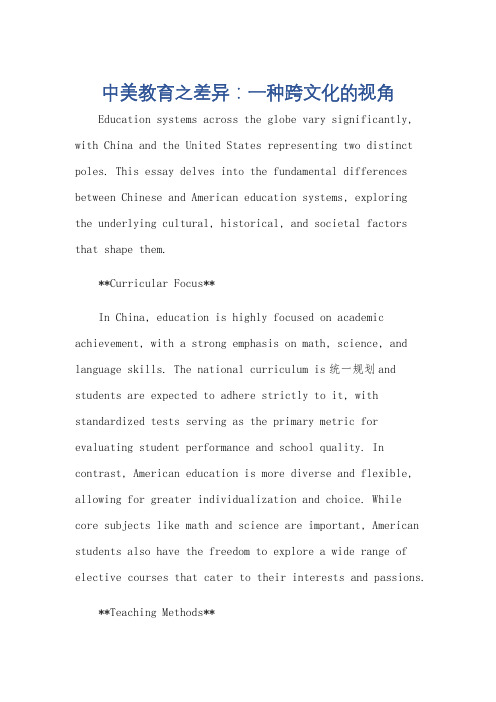
中美教育之差异:一种跨文化的视角Education systems across the globe vary significantly, with China and the United States representing two distinct poles. This essay delves into the fundamental differences between Chinese and American education systems, exploringthe underlying cultural, historical, and societal factors that shape them.**Curricular Focus**In China, education is highly focused on academic achievement, with a strong emphasis on math, science, and language skills. The national curriculum is统一规划and students are expected to adhere strictly to it, with standardized tests serving as the primary metric for evaluating student performance and school quality. In contrast, American education is more diverse and flexible, allowing for greater individualization and choice. While core subjects like math and science are important, American students also have the freedom to explore a wide range of elective courses that cater to their interests and passions. **Teaching Methods**Chinese classrooms are often characterized by ateacher-centered approach, with teachers playing adirective role in imparting knowledge. Lectures are common, and students are expected to actively participate and engage in discussions. In contrast, American classrooms are more student-centered, emphasizing active learning and critical thinking. Teachers often adopt a facilitator role, guiding students through projects and hands-on experiences that promote independent thinking and problem-solvingskills.**Assessment and Evaluation**Assessment in Chinese education is highly standardized, with national exams serving as the key determinant for admissions to universities and job opportunities. Thisfocus on high-stakes testing creates a competitive andoften stressful environment for students. By contrast, American education relies more on a holistic approach to evaluation, considering a range of factors including grades, extracurricular activities, recommendations, and personal essays. This approach aims to capture a more comprehensive picture of a student's abilities and potential.**Role of the Teacher**In China, teachers are highly respected and play a pivotal role in shaping students' academic and moral development. They are expected to act as mentors and role models, guiding students not only academically but also in their daily lives. In America, teachers are valued for their subject expertise but are often treated as professionals equal to other occupations. While they play an important role in education, they are not expected to serve as mentors or guardians outside the classroom.**The Impact of Societal Expectations**Chinese society places a high value on education, viewing it as the primary pathway to success and social mobility. This expectation is reflected in the intense focus on academic achievement and the rigorous study culture that prevails in Chinese schools. In contrast, American society is more diverse and open to different paths to success, allowing students to pursue a range of interests and career options outside the traditional academic track.In conclusion, the differences between Chinese and American education systems are profound and reflect the distinct cultural, historical, and societal contexts of the two countries. Understanding these differences is crucial for bridging the cross-cultural divide and fostering global understanding and cooperation.**中美教育之差异:一种跨文化的视角**全球各地的教育体系存在显著差异,其中中国和美国分别代表了两个截然不同的极端。
关于美国和中国家长教育区别英语作文

关于美国和中国家长教育区别英语作文Here is an English essay about the differences in parenting styles between the United States and China, with a word count of over 1000 words.Parenting Styles in the United States and China: A Comparative ExplorationThe approach to child-rearing can vary significantly across different cultures and societies. Two prominent examples are the United States and China, which often display distinct parenting philosophies and practices. Understanding these differences is crucial in navigating the complexities of raising children in a globalized world.In the United States, the dominant parenting style tends to emphasize individuality, independence, and self-expression. American parents often encourage their children to explore their interests, develop their own unique talents, and make autonomous decisions. The goal is to nurture well-rounded individuals who can think critically, make their own choices, and pursue their passions. This approach is rooted in the American cultural values of personal freedom, self-reliance, and the pursuit of happiness.American parents typically grant their children a significant degree of freedom and autonomy, allowing them to make mistakes and learn from their experiences. Failure is often seen as an opportunity for growth and resilience, rather than a source of shame or disappointment. Parents may provide guidance and support, but they generally refrain from exerting excessive control or imposing strict rules and expectations.Furthermore, American education systems tend to foster an environment that values creativity, innovation, and independent thinking. Students are encouraged to engage in open-ended discussions, challenge traditional ideas, and develop their own perspectives. The emphasis is on cultivating well-rounded individuals who can adapt to a rapidly changing world.In contrast, the Chinese approach to parenting is often characterized by a greater emphasis on academic achievement, filial piety, and collective harmony. Chinese parents typically place a strong emphasis on education, viewing it as the primary path to success and social mobility. They may set high academic standards for their children and invest significant time and resources in ensuring their children's educational attainment.The Chinese parenting style is heavily influenced by Confucianprinciples, which emphasize the importance of family, respect for elders, and the subordination of individual desires to the greater good of the collective. Chinese parents often prioritize the family's reputation and the child's ability to fulfill their filial obligations over the child's personal preferences and self-expression.As a result, Chinese parents may be more involved in their children's academic and extracurricular activities, providing extensive guidance and support. They may also be more likely to exert a higher degree of control over their children's choices, such as the selection of academic subjects, extracurricular activities, and even future career paths.The Chinese education system, in turn, tends to emphasize rote learning, exam-based assessment, and the mastery of core academic subjects. Students are often expected to conform to strict rules and regulations, and there is a strong emphasis on discipline, obedience, and the pursuit of excellence.It is important to note that these broad generalizations do not apply to all families within the United States and China. There is a wide range of diversity within each culture, and individual families may adopt a blend of different parenting approaches. Additionally, the globalization of ideas and the increasing cross-cultural exchange have led to some convergence and blending of parenting styles inrecent years.Nevertheless, the fundamental differences in the underlying cultural values and societal expectations between the United States and China continue to shape distinct parenting philosophies and practices. These differences can have significant implications for the development and well-being of children, as well as the dynamics of family relationships.For parents navigating the challenges of raising children in a multicultural world, understanding these cultural differences can be invaluable. It can help them to better empathize with and support their children, who may be exposed to diverse parenting approaches within their social and educational environments. Furthermore, it can encourage parents to critically examine their own assumptions and biases, and to adopt a more nuanced and flexible approach to parenting that considers the unique needs and circumstances of their children.In conclusion, the differences in parenting styles between the United States and China reflect the underlying cultural values, societal expectations, and educational systems of these two nations. While these distinctions can sometimes lead to misunderstandings and tensions, they also present opportunities for cross-cultural learning and the development of more holistic approaches to child-rearing.By embracing the diversity of parenting practices and finding common ground, parents can create an environment that nurtures the well-being and growth of children in a rapidly changing world.。
关于美国英语作文小学
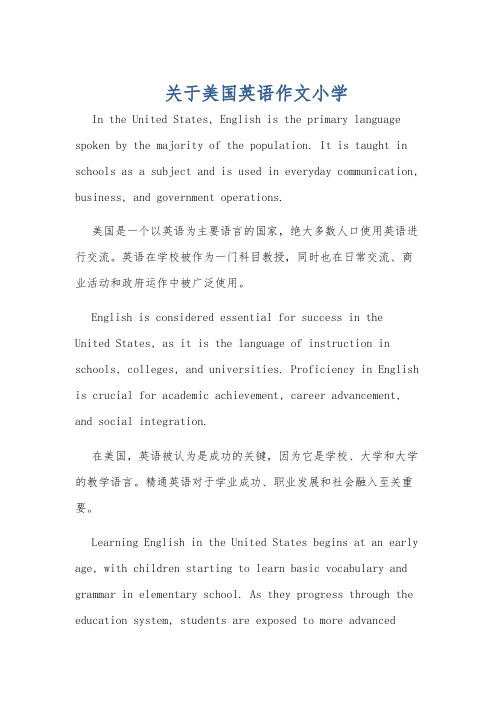
关于美国英语作文小学In the United States, English is the primary language spoken by the majority of the population. It is taught in schools as a subject and is used in everyday communication, business, and government operations.美国是一个以英语为主要语言的国家,绝大多数人口使用英语进行交流。
英语在学校被作为一门科目教授,同时也在日常交流、商业活动和政府运作中被广泛使用。
English is considered essential for success in the United States, as it is the language of instruction in schools, colleges, and universities. Proficiency in English is crucial for academic achievement, career advancement, and social integration.在美国,英语被认为是成功的关键,因为它是学校、大学和大学的教学语言。
精通英语对于学业成功、职业发展和社会融入至关重要。
Learning English in the United States begins at an early age, with children starting to learn basic vocabulary and grammar in elementary school. As they progress through the education system, students are exposed to more advancedlanguage skills and are required to write essays, give presentations, and participate in debates.在美国,学习英语始于幼儿时期,孩子们从小学开始学习基本词汇和语法。
美国教育孩子英语作文

美国教育孩子英语作文English:As a parent in the United States, educating your child in English is essential for their academic and professional success in the future. One of the ways to do this is by encouraging your child to read books in English regularly. Reading not only improves their vocabulary and comprehension skills, but it also exposes them to different writing styles and genres. Another important aspect of educating children in English is practicing speaking the language daily. This can be done through conversations at home, enrolling them in English language classes or programs, or even watching English movies or cartoons. Additionally, encouraging your child to write in English, whether it be through journaling, writing stories, or even writing emails, can significantly improve their written communication skills. Finally, exposing your child to English-speaking environments, such as through travel or cultural events, can help them become more comfortable and confident in using the language in real-life situations.中文翻译:作为美国家长,教育孩子学习英语对他们未来的学术和职业成功至关重要。
美国的教育英语作文

美国的教育英语作文Education in the United States。
Education in the United States is a complex and diverse system that provides students with a wide range of opportunities and resources. From early childhood education to higher education, the U.S. education system is designed to prepare students for success in the global economy and to promote social mobility.The U.S. education system is divided into different levels, including early childhood education, primary education, secondary education, and higher education. Early childhood education, which includes preschool and kindergarten, is not mandatory in the United States, but it is widely available and often considered an important foundation for later academic success.Primary education in the United States typically begins at age six and continues through fifth or sixth grade,depending on the state. Secondary education, which includes middle school and high school, generally begins at age 11 or 12 and continues through age 18. In high school, students have the opportunity to take a wide range of courses, including advanced placement (AP) courses, which can earn them college credit.After completing high school, students in the United States have the option to pursue higher education at colleges and universities. Higher education in the United States is known for its diversity and flexibility, with a wide range of institutions offering different types of degrees and programs. Students can choose from public universities, private universities, community colleges, and vocational schools, among others.One of the key features of the U.S. education system is its emphasis on extracurricular activities and enrichment programs. In addition to academic coursework, students in the United States have the opportunity to participate in a wide range of activities, including sports, music, drama, and community service. These activities are seen asimportant for developing well-rounded individuals and for promoting social and emotional development.Another important aspect of the U.S. education system is its commitment to diversity and inclusion. In recent years, there has been a growing emphasis on creating inclusive and equitable learning environments for all students, regardless of their background or identity. This includes efforts to address issues of bias and discrimination, as well as initiatives to promote cultural competence and diversity awareness.Despite its many strengths, the U.S. education system also faces a number of challenges. One of the most pressing issues is the achievement gap, which refers to thedisparity in academic performance between different groups of students, particularly along racial and socioeconomic lines. Efforts to close the achievement gap have been a major focus of education reform in the United States, with initiatives aimed at improving the quality of education in underserved communities and providing additional supportfor at-risk students.In conclusion, the U.S. education system is a complex and diverse system that provides students with a wide range of opportunities and resources. From early childhood education to higher education, the U.S. education system is designed to prepare students for success in the global economy and to promote social mobility. While it faces a number of challenges, the U.S. education system continues to be a key driver of social and economic progress in the United States.。
美国教育规章制度英语作文
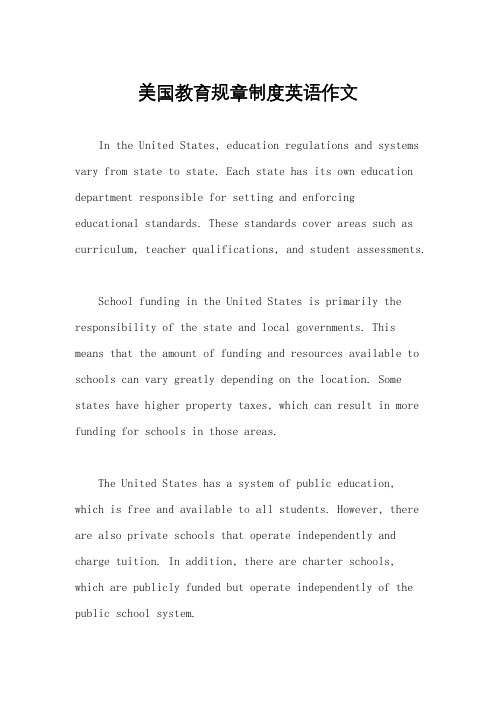
美国教育规章制度英语作文In the United States, education regulations and systems vary from state to state. Each state has its own education department responsible for setting and enforcingeducational standards. These standards cover areas such as curriculum, teacher qualifications, and student assessments.School funding in the United States is primarily the responsibility of the state and local governments. This means that the amount of funding and resources available to schools can vary greatly depending on the location. Some states have higher property taxes, which can result in more funding for schools in those areas.The United States has a system of public education, which is free and available to all students. However, there are also private schools that operate independently and charge tuition. In addition, there are charter schools, which are publicly funded but operate independently of the public school system.Standardized testing is a major part of the education system in the United States. Students are required to take standardized tests at various grade levels to assess their academic progress. These tests are often used to measure school performance and to hold schools and teachers accountable.In recent years, there has been a growing emphasis on the importance of early childhood education in the United States. Many states have implemented programs to provide early education opportunities for young children, with the goal of improving school readiness and academic success.The United States also has laws in place to ensure equal access to education for students with disabilities. The Individuals with Disabilities Education Act (IDEA) guarantees that students with disabilities receive a free and appropriate public education tailored to their individual needs.In conclusion, the education regulations and systems inthe United States are complex and multifaceted, with a focus on standards, funding, diversity of school options, standardized testing, early childhood education, and support for students with disabilities. These factors all contribute to the diverse and dynamic landscape of education in the United States.。
美国教育英语作文
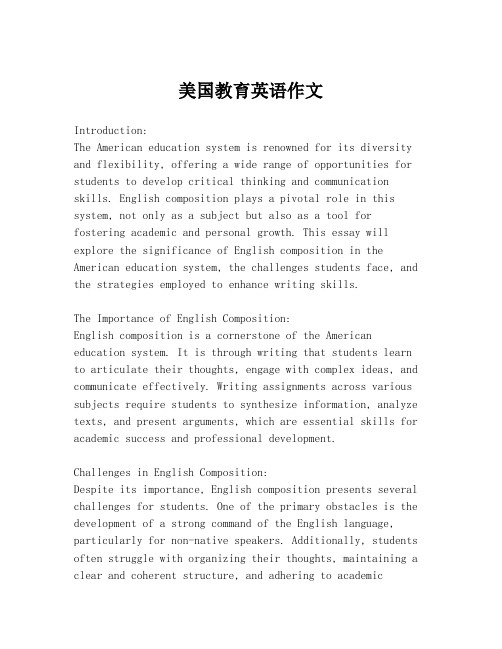
美国教育英语作文Introduction:The American education system is renowned for its diversity and flexibility, offering a wide range of opportunities for students to develop critical thinking and communication skills. English composition plays a pivotal role in this system, not only as a subject but also as a tool for fostering academic and personal growth. This essay will explore the significance of English composition in the American education system, the challenges students face, and the strategies employed to enhance writing skills.The Importance of English Composition:English composition is a cornerstone of the American education system. It is through writing that students learn to articulate their thoughts, engage with complex ideas, and communicate effectively. Writing assignments across various subjects require students to synthesize information, analyze texts, and present arguments, which are essential skills for academic success and professional development.Challenges in English Composition:Despite its importance, English composition presents several challenges for students. One of the primary obstacles is the development of a strong command of the English language, particularly for non-native speakers. Additionally, students often struggle with organizing their thoughts, maintaining a clear and coherent structure, and adhering to academicwriting conventions. Overcoming these challenges requires a combination of instruction, practice, and feedback.Strategies for Enhancing Writing Skills:Educators in the American education system employ various strategies to help students improve their English composition skills. These include:1. Writing Workshops: Interactive sessions where students can share their work, receive constructive criticism, and learn from their peers.2. Writing Centers: Support services that provide one-on-one assistance with writing assignments and offer guidance on grammar, style, and organization.3. Technology Integration: The use of software and online tools to help students with grammar checks, plagiarism detection, and research.4. Diverse Writing Assignments: Assigning a variety ofwriting tasks, such as essays, research papers, and creative writing, to cater to different learning styles and interests.5. Regular Feedback: Providing timely and detailed feedback on written work to help students understand their strengths and areas for improvement.Conclusion:English composition is an integral part of the American education system, playing a crucial role in the holistic development of students. By addressing the challenges and implementing effective strategies, educators can empower students to become proficient writers and communicators. As students progress through the education system, their abilityto express themselves through writing becomes a key factor in their academic achievements and future career prospects.。
美国的教育 英语作文

美国的教育英语作文Education in the United States。
Education in the United States is a complex and diverse system that includes both public and private institutionsat all levels. The system is structured to provide students with a broad range of educational opportunities, from preschool through graduate school, and to prepare them fora variety of careers and life experiences.The foundation of the American education system is the public school system, which is funded and administered by state and local governments. Public schools are free and open to all students, regardless of their social or economic background. They are required to provide a basic education to all students, including instruction in reading, writing, math, science, social studies, and physical education.In addition to public schools, there are many privateschools in the United States, which are funded by tuition and donations. Private schools vary widely in their size, curriculum, and philosophy, and can be religious or secular in nature. Some private schools offer specialized programsin areas such as the arts, technology, or international studies.Higher education in the United States is also diverse and includes a wide range of institutions, from community colleges to research universities. Community colleges offer two-year associate degrees and are often a more affordable option for students who want to complete their general education requirements before transferring to a four-year university. Four-year universities offer bachelor's degrees, and many also offer graduate programs that lead to master's or doctoral degrees.One of the unique features of the American education system is its emphasis on extracurricular activities. Students are encouraged to participate in sports, clubs,and other activities outside of the classroom, which can help them develop leadership skills, social connections,and a sense of community.Despite the strengths of the American education system, it also faces many challenges. One of the most significantis the achievement gap, which refers to the disparity in academic performance between different groups of students, particularly those from low-income and minority backgrounds. Other challenges include funding disparities between schools, teacher shortages, and the need to adapt torapidly changing technology and workforce demands.In conclusion, education in the United States is a complex and diverse system that provides students with a broad range of opportunities and prepares them for avariety of careers and life experiences. While there are many strengths to the system, there are also significant challenges that must be addressed in order to ensure thatall students have access to a high-quality education.。
美国教育 英语作文
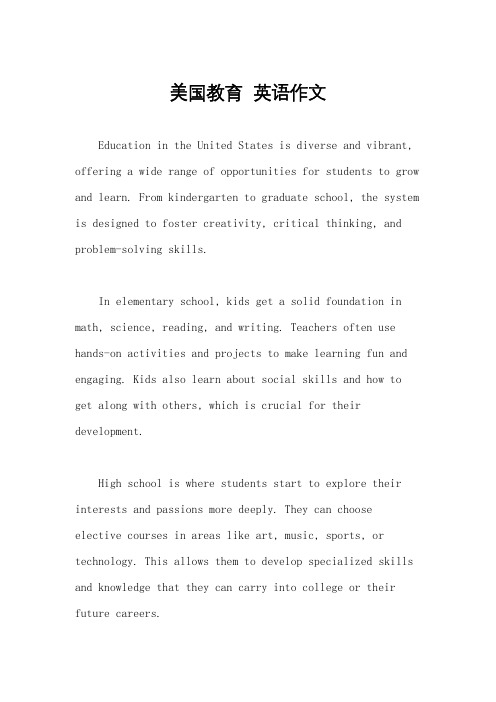
美国教育英语作文Education in the United States is diverse and vibrant, offering a wide range of opportunities for students to grow and learn. From kindergarten to graduate school, the system is designed to foster creativity, critical thinking, and problem-solving skills.In elementary school, kids get a solid foundation in math, science, reading, and writing. Teachers often use hands-on activities and projects to make learning fun and engaging. Kids also learn about social skills and how to get along with others, which is crucial for their development.High school is where students start to explore their interests and passions more deeply. They can chooseelective courses in areas like art, music, sports, or technology. This allows them to develop specialized skills and knowledge that they can carry into college or their future careers.College education in the US is known for its rigorous standards and emphasis on research. Students have the freedom to choose their majors and can often customize their degree programs to fit their interests and career goals. The campus life is also a big part of the college experience, with students participating in clubs,。
美国教育的英语作文
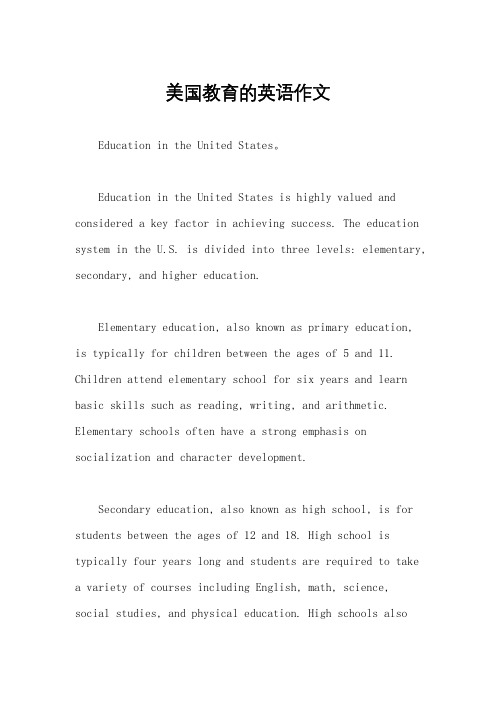
美国教育的英语作文Education in the United States。
Education in the United States is highly valued and considered a key factor in achieving success. The education system in the U.S. is divided into three levels: elementary, secondary, and higher education.Elementary education, also known as primary education,is typically for children between the ages of 5 and 11. Children attend elementary school for six years and learn basic skills such as reading, writing, and arithmetic. Elementary schools often have a strong emphasis on socialization and character development.Secondary education, also known as high school, is for students between the ages of 12 and 18. High school is typically four years long and students are required to take a variety of courses including English, math, science,social studies, and physical education. High schools alsooffer elective courses in areas such as art, music, and foreign languages.In the U.S., higher education is not mandatory, but itis highly encouraged. Higher education includes collegesand universities, which offer a variety of degree programs such as associate's, bachelor's, master's, and doctoral degrees. Higher education is often seen as a means to achieve higher paying jobs and greater career opportunities.The U.S. education system places a strong emphasis on standardized testing, which is used to evaluate student performance and determine school funding. The most well-known standardized tests are the SAT and ACT, which are college entrance exams.One of the biggest challenges facing the U.S. education system is the achievement gap, which refers to thedisparities in academic performance between different demographic groups such as race, ethnicity, and socioeconomic status. Many efforts have been made toaddress the achievement gap, including increased fundingfor schools in disadvantaged areas and the implementation of programs aimed at improving academic performance.Overall, education in the United States is highly valued and seen as a key factor in achieving success. While there are challenges facing the education system, efforts are being made to address them and improve the quality of education for all students.。
中美学校教育比较研究英语作文
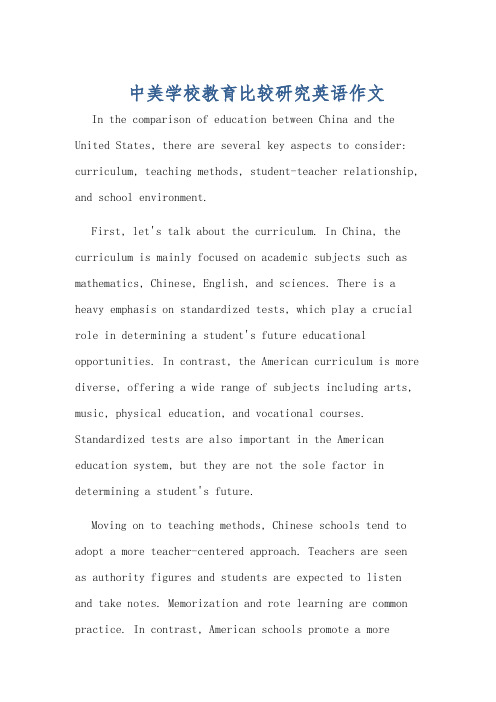
中美学校教育比较研究英语作文In the comparison of education between China and the United States, there are several key aspects to consider: curriculum, teaching methods, student-teacher relationship, and school environment.First, let's talk about the curriculum. In China, the curriculum is mainly focused on academic subjects such as mathematics, Chinese, English, and sciences. There is a heavy emphasis on standardized tests, which play a crucial role in determining a student's future educational opportunities. In contrast, the American curriculum is more diverse, offering a wide range of subjects including arts, music, physical education, and vocational courses. Standardized tests are also important in the American education system, but they are not the sole factor in determining a student's future.Moving on to teaching methods, Chinese schools tend to adopt a more teacher-centered approach. Teachers are seen as authority figures and students are expected to listen and take notes. Memorization and rote learning are common practice. In contrast, American schools promote a morestudent-centered approach, encouraging critical thinking, creativity, and active participation. Students are encouraged to ask questions, engage in discussions, and work collaboratively.The student-teacher relationship also differs between the two countries. In China, there is a strong emphasis on respect and discipline towards teachers. Teachers are seen as mentors and figures of authority. In the United States, the relationship is more informal, with teachers often being seen as facilitators and mentors. There is an emphasis on building a positive and supportive relationship between students and teachers.Lastly, the school environment in China and the United States is quite different. Chinese schools often havelarger class sizes, with a focus on maintaining discipline and order. The school day is longer, and students often have a significant amount of homework and extracurricular activities. In the United States, class sizes are typically smaller, allowing for more individualized attention and student interaction. The school day is shorter, and thereis less emphasis on homework and more on extracurricular activities and social development.总结起来,中美教育在课程设置、教学方法、师生关系和校园环境等方面存在着明显的差异。
英式教育和美式教育的区别英语作文
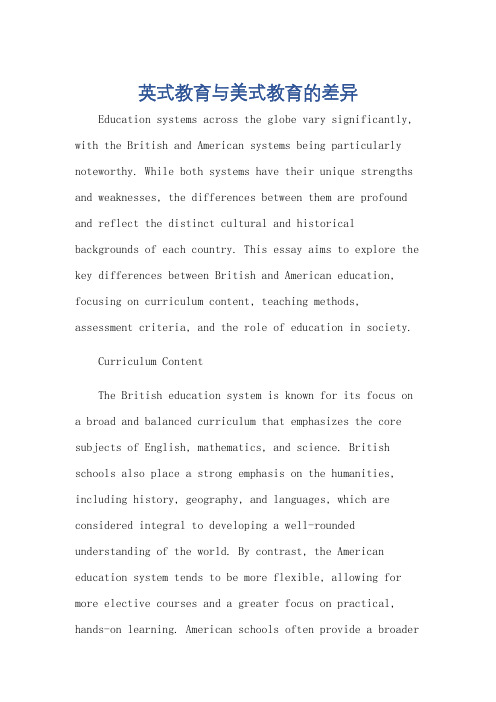
英式教育与美式教育的差异Education systems across the globe vary significantly, with the British and American systems being particularly noteworthy. While both systems have their unique strengths and weaknesses, the differences between them are profound and reflect the distinct cultural and historical backgrounds of each country. This essay aims to explore the key differences between British and American education, focusing on curriculum content, teaching methods, assessment criteria, and the role of education in society. Curriculum ContentThe British education system is known for its focus on a broad and balanced curriculum that emphasizes the core subjects of English, mathematics, and science. British schools also place a strong emphasis on the humanities, including history, geography, and languages, which are considered integral to developing a well-rounded understanding of the world. By contrast, the American education system tends to be more flexible, allowing for more elective courses and a greater focus on practical, hands-on learning. American schools often provide a broaderrange of subjects, including those related to the arts, technology, and vocational training.Teaching MethodsTeaching methods in British schools tend to be more traditional, with a focus on lectures and textbooks. Teachers play a directive role, guiding students through the material and ensuring that they are meeting the required standards. In contrast, American schools often adopt a more student-centered approach, encouraging active learning and hands-on experiences. Teachers in the United States tend to act as facilitators, guiding students towards independent discovery and encouraging critical thinking.Assessment CriteriaAssessment criteria in British schools are typically more focused on academic achievement, with exams and tests playing a significant role. British students are expected to demonstrate a high level of proficiency in core subjects and to achieve high grades in order to progress to the next level of education. In the United States, however, assessment is often more diverse, incorporating a range ofcriteria such as participation, creativity, and practical skills. American schools also tend to place a greater emphasis on continuous assessment, with teachers providing regular feedback to students throughout the year.The Role of Education in SocietyThe role of education in British society is highly valued, with a strong emphasis on academic excellence and the pursuit of higher education. British society tends to view education as a means of social mobility and as a prerequisite for success in many professions. In the United States, education is also highly valued, but there is a greater emphasis on practicality and vocational training. American society tends to view education as a means of preparing students for the workforce and as a tool for economic growth and development.In conclusion, the differences between British and American education systems are numerous and reflect the distinct cultural and historical backgrounds of each country. British education focuses on a broad and balanced curriculum, traditional teaching methods, and academic assessment, while American education emphasizes flexibility,student-centered learning, and a more diverse range of assessment criteria. Both systems have their strengths and weaknesses, and it is important to recognize the value of both approaches in order to create a more comprehensive and inclusive education system.**英式教育与美式教育的差异**全球的教育体系存在显著的差异,其中英式教育和美式教育尤为引人注目。
- 1、下载文档前请自行甄别文档内容的完整性,平台不提供额外的编辑、内容补充、找答案等附加服务。
- 2、"仅部分预览"的文档,不可在线预览部分如存在完整性等问题,可反馈申请退款(可完整预览的文档不适用该条件!)。
- 3、如文档侵犯您的权益,请联系客服反馈,我们会尽快为您处理(人工客服工作时间:9:00-18:30)。
关于美国教育英语作文
英语作文,是指用英语针对某一内容写出一篇文章,是英语考试最常见的一种题目类型,英语作文要求阅读、写作比较高,也是考生最容易失分的题型。
关于美国教育的英语作文应该怎么写?
关于美国教育英语作文篇一:In China, the college entrance exam is believed to be the most cruel exam, which will decide a student’s future. Many young people complain about this educational system, they yearn for the western education, which is reported to be much eaiser. But the fact is that not all foreign students like that.
在中国,高考被认为是最残酷的考试,这将决定一个学生的未来。
许多年轻人抱怨这个教育体系,他们渴望西方的教育,西方教育一直被媒体报道上学轻松。
但事实是,不是所有的外国学生都是这样轻松。
In America, high school students also need to take the very important exam so as to enter the college. Part of students choose to study in community college or just go to work, so they don’t have much pressure. They enjoy the high school life with joining many activities and taking all kinds of parties. But for the students who want to enter the top university, high school is not easy for them. They need to spend extra hours to study after class, which is much like Chinese students.
————来源网络搜集整理,仅供个人学习查参考
在美国,高中学生也需要参加非常重要的考试,为了上大学。
一部分学生选择在社区大学学习或者是直接工作,所以他们没有太多的压力。
他们享受高中生活,加入许多活动和各种各样的派对。
但是那些想进入顶尖大学的学生,高中是不容易的。
他们需要花额外的时间去课后学习,就像中国学生。
Actually, no matter in which country, every student needs to spend a lot of time studying in order to be competitive. If you yearn for an ease environment in high school, then you’d better prepare for the unexpected future.
其实,不管在哪个国家,每个学生都需要花大量的时间学习,才能有竞争力。
如果你渴望在高中处于一个轻松的环境,那么你最好准备好迎接意想不到的未来。
关于美国教育英语作文篇二:Higher Education in America There is evidence that even incomplete university study gives a person better career prospects than none at all. So, it is accepted that the benefits of a university career are useful.
All this effort in America’s higher education is very expensive. Some of the costs come from fees and benefactions, particularly towards research, but most have to be paid from public funds. Parents favor big expenditures on higher education; a wider public opinion favors them for idealistic and cultural reasons, and because of the supposed value of education as an investment by society.
The first universities were developed by private charitable organizations. The private universities are still very important, and most of the best-known institutions, like Harvard, Yale and Princeton, are private.
Most of the principal state universities have between 10, 000 and 30, 000 students, and some have increased rapidly in the past few years. Private universities and colleges are generally smaller, and although they are more numerous than public institutions they have a smaller total number of students than those in public institutions. The private colleges vary very much in standards and reputation, from the world-famous and select to the cranky and the obscure①. The best known of all is Harvard.
There are also many junior colleges to which students may be admitted at the end of their high school career, providing only the first two years of university work.
For the most part Americans think that there’s some advantage in attending one of the better-known private institutions, in spite of the higher cost, rather than a state university. However, testate universities are becoming increasingly important, and some of them, particularly in the Midwest have a reputation practically equal to that of the private ones. Almost every state by now has several university institutions directly under the authority of the state
government.。
